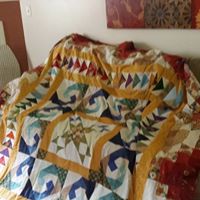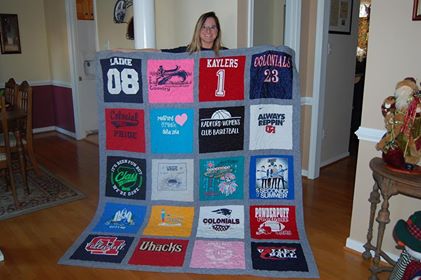The Creative Sweet Spot with a Professional Quilter
- HelloQuiltPatch
- Oct 14, 2020
- 4 min read
Updated: Nov 16, 2021
The Featured Writer of October: Heather Stocker
Heather shares how she has learned that process can be more important than outcome—even as a professional quilter.
If you would like to see more of my featured writers, sign up for my monthly Newsletter here!
Sweating the small stuff has been my m.o. for quite some time. I am in constant pursuit of perfection—the sort of the Platonic ideal that all quilts are modeled after, the perfect quilt that can never exist in this earthly realm, but instead remains in the ether. It’s the holy grail of imagination—utterly attractive and completely unattainable.
I know within my bones this isn’t a healthy way of judging my own work. I don’t judge others’ work this way, so I’ve been practicing giving myself the grace I so freely give to others, and that has opened up an unexpected space for me.

I’m still in pursuit of perfection. I find I thrive creatively in the space where imagination runs free. In between sleep and waking, I can see, in full color, quilt designs I want to make, but my sketches never quite match what my brain produced so easily. Often these imagined quilts bring me to a deeper space where rules are broken and “tradition” is to be learned from.

That in between place where we sense perfection just out of reach is what I grasp for when making a new quilt, and this often means running afoul of rules. Some would call it flow. Others would say it is risk-taking. My creativity needs to run free, but not too free. I need some rules, but not too many.
Case in point: learning to make t-shirt quilts, I followed every step. Every. One. I interfaced hundreds of shirts, grousing and complaining the entire time, until one day I ran out of interfacing and said, “Why am I doing this? I hate it.”
I was doing it because everyone, including myself, said I must in order to make “the perfect t-shirt quilt.” What does that even mean? When an activity saps joy can the product ever be perfect? And if it is “perfect” then what of the human experience? I’ve come to believe that process can be more important than outcome—even as a professional quilter.
People come to me often at the tail end of grief. They want a memory quilt. They want to remember the concert they went to with their husband, or how their sister played soccer in 6th grade and made the all-star team. The perfection of the moment isn’t in the quilt, but in the human experience and in years of memories that I will never access. Human experience is messy and often includes tears of joy and loss, of being vulnerable and human. And that is where such a quilt’s beauty lies.

Striving to make MY perfect, idealized quilt means I’m ignoring the most important part of the entire equation: the human experience. The client’s as well as mine.
So I quit grousing over interfacing. In fact, I began working without it, which has its own challenges, I can assure you, but breaking that one, simple rule brought joy back into my job. Today I never stabilize my quilts—EVER. I don’t need to.
I moved from stifling tradition to creative freedom. Tradition is to be used as a tool, much like a seam ripper or the proper foot. When the tool no longer fits, reach for a different tool.
I also help other quilters who want to break the rules. Why not? You might stumble upon something—a new technique, an easier method—that allows you to get the results you want.
And me having joy means I am freer to provide the best quilt possible for my clients. It may not be my personal ideal vision, but it is theirs. There is beauty in service to someone else’s vision.

Creativity needs restraint, but too much creates stagnation. Creativity also calls for us to be nudged out of our comfort zones, and into the unknown.
This sort of risk-taking frightens some quilters and that is OK. If you like working with certainty, there is nothing wrong with that approach, but if you have a still, small voice that is sowing discontent on the edges of your mind, rule breaking may be what you need.
It’s OK to do a quick evaluation targeting that one thing that you simply hate and finding a solution through rule breaking. Maybe it’s buying only pre-cuts to eliminate cutting as much as possible. Maybe it’s allowing others to design for you. Maybe it’s sending your quilt to a longarmer. Whatever it is that you need to pass off or pass on, do it.
The freedom you will have by eliminating what you really don’t like will make space for new creativity to shine.
~ Heather M. Stocker

Heather Stocker is the owner of Bon Air Quilt Company in Richmond, VA, where she lives with her husband and two (mostly grown) children. She started her company at the beginning of a pandemic because she loves a challenge and there is no better time to quilt than during quarantine. You can find her @bonairquiltco on Facebook and Instagram, and in her shop at bonairquiltco.com.
Enjoy the Slideshow below!
If you would like to see our future Featured Writers, feel free to subscribe to my newsletter here.














Commentaires